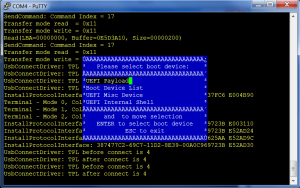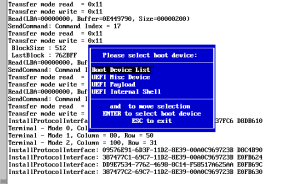Even if you only ever plan to run Windows or stock distributions of Linux that already have secure boot support, I’d encourage everybody who has a new UEFI secure boot platform to take ownership of it. The way you do this is by installing your own Platform Key. Once you have done this, you can use key database maintenance tools like keytool to edit all the keys on the Platform and move the platform programmatically from Setup Mode to User Mode and back again. This blog post describes how you go about doing this.
First Save the Variables
The first thing to do is to install and run KeyTool either directly (the platform must have secure boot turned off, because keytool is unsigned) or via the mini USB image and save all the current secure variable keys (select the ‘Save Keys’ option from the top level menu). This will save the contents of each variable as a single esl (EFI Signature List) file, so you should end up with three files: PK.esl, KEK.esl and db.esl. These files can later be used to restore the contents if something goes wrong in the updates (and because some platforms put you into setup mode by erasing the contents of all the secure variables), so save them in a safe place.
Use the UEFI Menus to remove the Platform Key
This is the step that it’s impossible to be precise about. Every UEFI platform seems to be different in how you do this. The Linux Foundation hosts a web page collecting the information but so far it only has the Intel Tunnel Mountain system on it, but if you work it out for your platform, leave me a comment describing what you did and I’ll add it to the LF page.
The most common way to get a UEFI system to display the UEFI menus is to press ESC as it boots up.
Create your own Platform Key
If you rpm installed efitools, it will automatically have created a Platform Key for you in /usr/share/efitools/keys, plus all of the PK.auth and noPK.auth files.
A platform key may be self signed, but doesn’t have to be (I’m using one signed with my root certificate). However, assuming you want to create a self-signed platform key manually, here are the steps: The standard command for doing this with openssl is
openssl req -new -x509 -newkey rsa:2048 -subj “/CN=<my CN text>/” -keyout PK.key -out PK.crt -days 3650 -nodes -sha256
None of the parameters for the key (Like the Common Name) matters, so you can replace <my CN text> with anything you like (mine says ‘James Bottomley Platform Key 2013’) you can also add other X509 well known objects like your address. Once you have the two files PK.crt and PK.key, you need to save them in a safe location (PK.key is the one to guard since it’s your private key).
Next, create an EFI Signature List file with the public key in (this and the next steps require that you have either installed the efitools rpm or compiled the unix commands from efitools.git and installed them on your system)
cert-to-efi-sig-list -g <my random guid> PK.crt PK.esl
where <my random guid> is any random GUID you choose. You also need to create an empty noPK.esl file which can be used to remove the platform key again
> noPK.esl
(do an ls -l on it to make sure it has zero size).
Now you create the signed update files (called .auth files)
sign-efi-sig-list -k PK.key -c PK.crt PK PK.esl PK.auth
sign-efi-sig-list -k PK.key -c PK.crt PK noPK.esl noPK.auth
copy the two .auth files to your USB key and you should now be able to use KeyTool to insert them into where the platform key is. Go to ‘Edit Keys’, select the ‘The Platform Key (PK)’ and then ‘Replace Keys(s)’. Navigate the file Chooser to your PK.auth file and you now are the platform Owner. Press ESC to go to the top level menu and it should tell you the platform is in User Mode and Secure Boot is enabled. Now verify you can move back to Setup Mode by going to ‘Edit Keys’, ‘The Platform Key (PK)’ and this time selecting the first entry (showing the GUID you chose for your platform key) and then ‘Delete with .auth file’. This time navigate to noPK.auth and select it. The platform key should now be gone and when you ESC to the top menu it will tell you you are in Setup Mode. You now own your own platform and can move easily between setup and user modes.
Replace or Edit the rest of the Keys
Now you own your own platform, restoring or replacing the current platform keys is easy. Where you saved the original keys, you should have a KEK.esl and a db.esl file. If you find that KEK and db are blank, you can restore them with this file, simply place the platform into Setup Mode, go to ‘Edit Keys’, ‘The Key Exchange Key Database (KEK)’ and ‘Replace Key(s)’ and finally navigate to the KEK.esl file you saved. You can also do the same thing with db.esl
Now your platform should be back to its original condition except that you own the Platform Key and can decide easily to flip it into Setup Mode. Once in setup mode, you can edit the actual keys. One thing you can do is create your own signature key (using the method above for PK) and place it into db. You could also (assuming you never plan to boot windows) delete all the microsoft keys from the system. Beware if you decide to do this that some of your UEFI drivers may be signed by microsoft keys, and removing them all may limit the functionality of your UEFI platform. Additionally, any UEFI update to your system is also likely to come signed with the microsoft keys, however, in this case you can put the Microsoft keys back before doing the update.
If pieces of your UEFI system do need to be signed, it might be possible to extract them and sign them with your key instead of Microsoft’s, but I haven’t yet found a system that needs this, so I don’t really have much of an idea how to do it.
Remember to move your platform back to User Mode to enable secure boot before you exit KeyTool.

